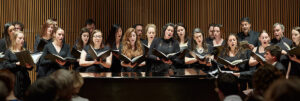The Manhattan Choral Ensemble Sings Victoria (Concert review)
The Manhattan Choral Ensemble, Thomas Cunningham, Director
The Victoria Requiem
Church of the Blessed Sacrament
May 18, 2024
By Christian Carey for Sequenza 21
NEW YORK – The Manhattan Choral Ensemble is an auditioned forty-voice group. Among them are enthusiastic amateurs, professional singers who want to work with Director Thomas Cunningham, who is a dynamic musician and imaginative programmer, and singers from music-adjacent pursuits, notably musical theater. A diverse group to be sure, but they sing beautifully together.
The main offering on their May concert program was by Tomas Luis de Victoria (1548-1611), his Requiem Mass, published in 1605. Victoria was chaplain in Madrid to Empress Maria, and the piece was written for her funeral in 1603. It is one of the most highly regarded works of the late Renaissance.
MCE performed both the chant and polyphonic portions of the mass, impressively tuned in unison passages and counterpoint alike. Cunningham took tempos realistic for a forty-voice group. At the same time, he urged them to sing in animated fashion, crafting a rendition of the Requiem that retained a sense of period practice.
Recognizing that his audience came to the concert with varying levels of background, Cunningham introduced the Requiem with a brief overview. Between sections, he discussed the piece, pointing out aspects of the music to listen for and features of its text. It was an excellent way to help attendees listen to a piece in liturgical Latin, and in a style that may have been foreign to some of them.
The program included a few other pieces interspersed with movements of the Requiem. While including texts that were appropriate additions, this afforded listeners a pause from Victoria’s musical language. Beati quorum via, by Charles Villiers Stanford (1852-1924), is broken into sections of women and men in canon that then come together in sumptuous harmonies. The piece affords the sopranos an opportunity to sing in soaring upper lines, and the other parts each to access their best respective registers, the conclusion saving and savoring the low basses.
Abendlied by Josef Gabriel Rheinberger (1839-1901) is a gently lyrical piece using short imitative exchanges that alternate with homophonic passages and cadences redolent of late Romanticism. The concert concluded with In Paradisum, by Z. Randall Stroope (b. 1953), which is dedicated, “In honor of the victims of the coronavirus pandemic, and the thousands of families left behind.” A touching composition in a colorful pantonal language with rich dynamic contrasts, including swelling crescendos and gently reflective pianissimo passages. This was followed by a brief Responsorium in plainchant. The additions to the program demonstrated the versatility of MCE, capable of performing early music, emotive Romantic fare, and a challenging twenty-first century piece.
Visual art is often featured as part of the group’s presentations. Allison Walker created beautiful, abstract prints that were placed around the performance space, illuminating each of the movements of the Requiem. Art, music, and an interspersed lecture all served to support a memorable performance by the Manhattan Choral Ensemble.

